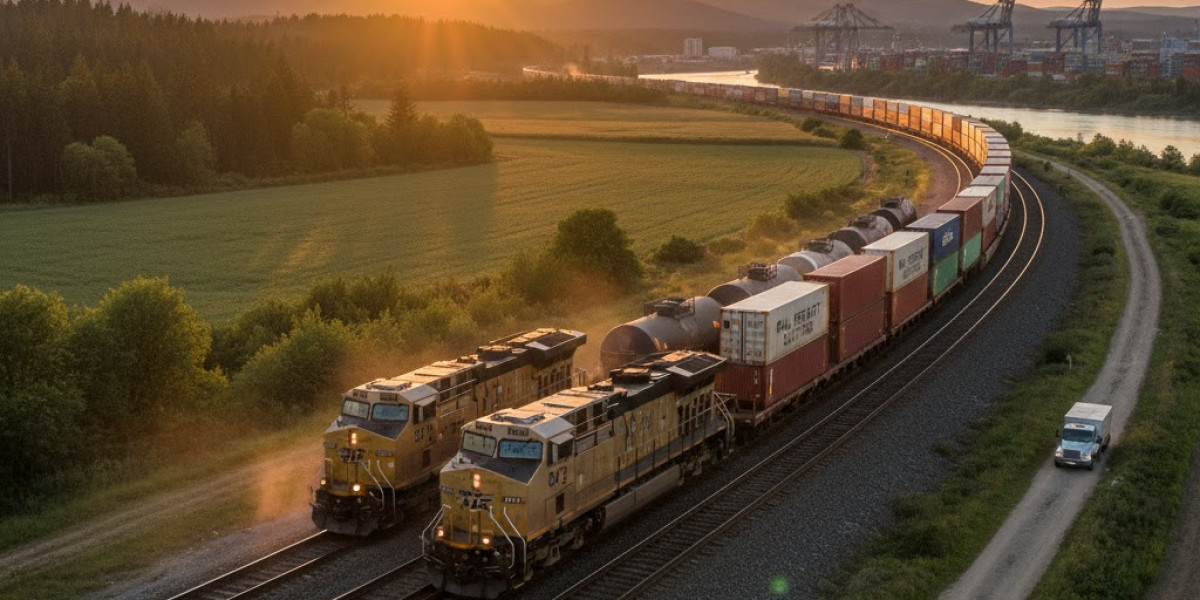The global rail freight sector is set for a decade of sustained expansion, with market size projected to grow from USD 370 billion in 2025 to USD 602.7 billion by 2035, reflecting a healthy CAGR of 5%. This trajectory highlights the enduring role of rail as a cost-effective, reliable, and environmentally sustainable backbone of international and domestic supply chains.
Year-on-year growth underscores consistent demand: from USD 370.0 billion in 2025 to USD 388.5 billion in 2026, rising to USD 407.9 billion in 2027, and continuing steadily through USD 449.7 billion by 2029. By 2035, the market is expected to reach USD 602.7 billion, signaling growing reliance on rail for bulk commodities and intermodal cargo, even amid competition from road, air, and maritime alternatives.
Containerized Cargo and Full Carload Services Lead the Way
The containerized cargo segment is expected to maintain its dominance, accounting for 46.8% of the market in 2025. Standardized containers simplify handling, improve security, and enable seamless integration with intermodal networks connecting ports, inland terminals, and final delivery points. This has been particularly transformative for industries that rely on timely and reliable logistics, including consumer goods, industrial machinery, and manufacturing supplies.
Full carload (FCL) services further underpin growth, projected to contribute 52.4% of market revenue in 2025. High-volume shippers in mining, chemicals, and agriculture increasingly favor dedicated railcars, benefiting from predictable schedules, minimized handling, and long-term contracts. By ensuring cost efficiency over long distances, FCL services continue to solidify rail freight as a competitive alternative to road transport.
Long-haul transport dominates distance-based segments, with 58.9% of market revenue in 2025. Rail’s efficiency in covering extended distances at lower per-ton-kilometer costs, combined with electrification and modern corridor infrastructure, makes it the preferred option for shippers seeking sustainable logistics solutions.
Regional Growth and Strategic Corridors
North America, Asia-Pacific, and Europe are key growth regions, each investing heavily in rail infrastructure. China leads with a projected CAGR of 6.8%, fueled by Belt and Road corridor development, double-stack container trains, and integration of port and inland logistics. India follows closely with a CAGR of 6.3%, supported by Dedicated Freight Corridors, modern wagons, automated yards, and intermodal hubs. Germany is projected to grow at 5.8%, benefiting from EU-backed TEN-T and Rhine-Alpine routes, while the UK and the US record steady gains at 4.8% and 4.3% respectively.
Cross-border and bulk cargo demand is rising, driven by industries such as automotive, chemicals, and construction materials. Expanding intermodal corridors connecting Asia to Europe, as well as robust domestic networks in North America, are providing businesses with reliable and cost-efficient logistics alternatives.
Technology and Modernization Fuel Efficiency
Investments in modern rolling stock, electrification, digital tracking, and predictive maintenance are enhancing operational reliability. Inland dry ports, intermodal terminals, and smart signaling systems allow for seamless integration of multimodal supply chains. Rail operators are leveraging digital platforms for real-time tracking, predictive analytics, and route optimization, creating opportunities to differentiate service offerings and meet evolving industry expectations.
Competitive Landscape: Established and Emerging Players
The rail freight market balances large, vertically integrated incumbents with specialized regional operators. Key players include BNSF Railway, Canadian National Railway, Canadian Pacific Railway, China Railway Corporation, CSX Corporation, Deutsche Bahn AG, DHL Group, Norfolk Southern Railway, SNCF Logistics, and Union Pacific Railroad. While incumbents leverage scale and integrated networks to offer end-to-end services, smaller and niche operators compete by focusing on specialized corridors, last-mile connectivity, or under-served trade routes.
Emerging players are increasingly entering the market, spurred by digitalization, private-public partnerships, and sustainable transportation incentives. Innovation in railcar design, energy-efficient locomotives, and intermodal services is opening avenues for new entrants seeking to establish competitive footholds alongside established operators.
Outlook: A Backbone for Global Trade
With rail freight representing approximately 18% of global freight transportation and nearly 21% of intermodal transport, the sector remains integral to international supply chains. Cost efficiency, sustainability, and reliability position rail as a strategic lever for industries and governments planning long-term logistics strategies.
As global trade volumes grow and logistics networks become more integrated, the rail freight market is expected to remain resilient, technologically advanced, and central to the movement of goods worldwide. Both established operators and new entrants have opportunities to expand, innovate, and shape the future of freight transport, ensuring rail continues to play a pivotal role in global commerce through 2035 and beyond.
Get this Report at $5000 | Get Your Discounted Report Now: https://www.futuremarketinsights.com/reports/sample/rep-gb-25427
Shop Market Research Reports Now: https://www.futuremarketinsights.com/checkout/25427
About the Report
This analysis covers rail freight market dynamics across cargo types, service types, distances, end-user industries, and geographic regions, profiling leading companies and highlighting trends in intermodal integration, digital adoption, and sustainability initiatives.
About Future Market Insights (FMI)
Future Market Insights, Inc. (ESOMAR certified, recipient of the Stevie Award, and a member of the Greater New York Chamber of Commerce) offers profound insights into the driving factors that are boosting demand in the market. FMI stands as the leading global provider of market intelligence, advisory services, consulting, and events for the Packaging, Food and Beverage, Consumer Technology, Healthcare, Industrial, and Chemicals markets. With a vast team of over 400 analysts worldwide, FMI provides global, regional, and local expertise on diverse domains and industry trends across more than 110 countries.







